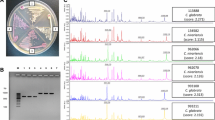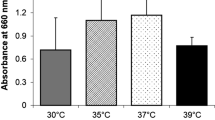Abstract
Background
Candida nivariensis and C. bracarensis have been recently identified as emerging yeast pathogens which are phenotypically indistinguishable from C. glabrata. However, there is little data on the prevalence and antifungal susceptibilities of these species.
Objective
This study investigated the occurrence of C. nivariensis and C. bracarensis in a culture collection of 185 C. glabrata isolates at a Malaysian teaching hospital.
Methods
C. nivariensis was discriminated from C. glabrata using a PCR assay as described by Enache-Angoulvant et al. (J Clin Microbiol 49:3375–9, 2011). The identity of the isolates was confirmed by sequence analysis of the D1D2 domain and internal transcribed spacer region of the yeasts. The isolates were cultured on Chromogenic CHROMagar Candida ® agar (Difco, USA), and their biochemical and enzymic profiles were determined. Antifungal susceptibilities of the isolates against amphotericin B, fluconazole, voriconazole and caspofungin were determined using E tests. Clotrimazole MICs were determined using a microbroth dilution method.
Results
There was a low prevalence (1.1 %) of C. nivariensis in our culture collection of C. glabrata. C. nivariensis was isolated from a blood culture and vaginal swab of two patients. C. nivariensis grew as white colonies on Chromogenic agar and demonstrated few positive reactions using biochemical tests. Enzymatic profiles of the C. nivariensis isolates were similar to that of C. glabrata. The isolates were susceptible to amphotericin B, fluconazole, voriconazole and caspofungin. Clotrimazole resistance is suspected in one isolate.
Conclusion
This study reports for the first time the emergence of C. nivariensis in our clinical setting.



Similar content being viewed by others
References
Fraser M, Borman AM, Johnson EM. Evaluation of the commercial rapid trehalose test (GLABRATA RTT) for the point of isolation identification of Candida glabrata isolates in primary cultures. Mycopathologia. 2012;173:259–64.
Malani A, Hmoud J, Chiu L, Carver PL, Bielaczyc A, Kauffman CA. Candida glabrata fungemia: experience in a tertiary care center. Clin Infect Dis. 2005;41:975–81.
Pfaller MA, Diekema DJ. Epidemiology of invasive candidiasis: a persistent public health problem. Clin Microbiol Rev. 2007;20:133–63.
Alcoba-Florez J, Mendez-Alvarez S, Cano J, Guarro J, Perez-Roth E, del Pilar Arevalo M. Phenotypic and molecular characterization of Candida nivariensis sp. nov., a possible new opportunistic fungus. J Clin Microbiol. 2005; 43: 4107-11.
Correia A, Sampaio P, James S, Pais C. Candida bracarensis sp. nov., a novel anamorphic yeast species phenotypically similar to Candida glabrata. Int J Syst Evol Microbiol. 2006;56:313–7.
Borman AM, Petch R, Linton CJ, Palmer MD, Bridge PD, Johnson EM. Candida nivariensis, an emerging pathogenic fungus with multidrug resistance to antifungal agents. J Clin Microbiol. 2008;46:933–8.
Fujita S, Senda Y, Okusi T, et al. Catheter-related fungemia due to fluconazole-resistant Candida nivariensis. J Clin Microbiol. 2007;45:3459–61.
Lockhart SR, Messer SA, Gherna M, et al. Identification of Candida nivariensis and Candida bracarensis in a large global collection of Candida glabrata isolates: comparison to the literature. J Clin Microbiol. 2009;47:1216–7.
Warren TA, McTaggart L, Richardson SE, Zhang SX. Candida bracarensis bloodstream infection in an immunocompromised patient. J Clin Microbiol. 2010;48:4677–9.
Bishop JA, Chase N, Lee R, Kurtzman CP, Merz WG. Production of white colonies on CHROMagar Candida medium by members of the Candida glabrata clade and other species with overlapping phenotypic traits. J Clin Microbiol. 2008;46:3498–500.
Bishop JA, Chase N, Magill SS, Kurtzman CP, Fiandaca MJ, Merz WG. Candida bracarensis detected among isolates of Candida glabrata by peptide nucleic acid fluorescence in situ hybridization: susceptibility data and documentation of presumed infection. J Clin Microbiol. 2008;46:443–6.
Romeo O, Scordino F, Pernice I, Lo Passo C, Criseo G. A multiplex PCR protocol for rapid identification of Candida glabrata and its phylogenetically related species Candida nivariensis and Candida bracarensis. J Microbiol Methods. 2009;79:117–20.
Mirhendi H, Bruun B, Schønheyder HC, et al. Differentiation of Candida glabrata, C. nivariensis and C. bracarensis based on fragment length polymorphism of ITS1 and ITS2 and restriction fragment length polymorphism of ITS and D1/D2 regions in rDNA. Eur J Clin Microbiol Infect Dis. 2011;30:1409–16.
Alcoba-Flórez J, Arévalo Mdel P et al. PCR protocol for specific identification of Candida nivariensis, a recently described pathogenic yeast. J Clin Microbiol. 2005; 43: 6194–6.
Enache-Angoulvant A, Guitard J, Grenouillet F, et al. Rapid discrimination between Candida glabrata, Candida nivariensis, and Candida bracarensis by use of a singleplex PCR. J Clin Microbiol. 2011;49:3375–9.
Ruma-Haynes P, Brownlee AG, Sorrell TC. A rapid method for detecting extracellular proteinase activity in Cryptococcus neoformans and a survey of 63 isolates. J Med Microbiol. 2000;49:733–7.
Price MF, Wilkinson ID, Gentry LO. Plate method for detection of phospholipase activity in Candida albicans. Sabouraudia. 1982;20:7–14.
White TJ, Bruns TD, Lee SB, Taylor JW. Amplification and direct sequencing of fungal ribosomal DNA for phylogenetics. In: Innis MA, Gelfand DH, Sninsky JJ, White TJ, editors. PCR protocols: a guide to the methods and applications. New York: Academic Press; 1990. p. 315–22.
Kurtzman CP, Robnett CJ. Identification of clinically important ascomycetous yeasts based on nucleotide divergence in the 5′ end of the large-subunit (26S) ribosomal DNA gene. J Clin Microbiol. 1997;35:1216–23.
Tamura K, Peterson D, Peterson N, Stecher G, Nei M, Kumar S. MEGA5: molecular evolutionary genetics analysis using maximum likelihood, evolutionary distance, and maximum parsimony methods. Mol Biol Evol. 2011;28:2731–9.
Clinical and Laboratory Standards Institute, 2008. Reference method for broth dilution antifungal susceptibility testing of yeasts. Approved standard CLSI document M27-A3. 3rd edn. Wayne: CLSI, 2008.
Pelletier R, Peter J, Antin C, Gonzalez C, Wood L, Walsh TJ. Emergence of resistance of Candida albicans to clotrimazole in human immunodeficiency virus-infected children: in vitro and clinical correlations. J Clin Microbiol. 2000;38:1563–8.
Cuenca-Estrella M, Gomez-Lopez A, Isla G, et al. Prevalence of Candida bracarensis and Candida nivariensis in a Spanish collection of yeasts: comparison of results from a reference centre and from a population-based surveillance study of candidemia. Med Mycol. 2011;49:525–9.
Esposto MC, Prigitano A, Romeo O, et al. Looking for Candida nivariensis and C. bracarensis among a large Italian collection of C. glabrata isolates: results of the FIMUA working group. Mycoses. 2013;56:394–6.
Wahyuningsih R, SahBandar IN, Theelen B, et al. Candida nivariensis isolated from an Indonesian human immunodeficiency virus-infected patient suffering from oropharyngeal candidiasis. J Clin Microbiol. 2008;46:388–91.
Chowdhary A, Randhawa HS, Khan ZU, et al. First isolations in India of Candida nivariensis, a globally emerging opportunistic pathogen. Med Mycol. 2010;48:416–20.
Sharma C, Wankhede S, Muralidhar S, et al. Candida nivariensis as an etiologic agent of vulvovaginal candidiasis in a tertiary care hospital of New Delhi, India. Diagn Microbiol Infect Dis. 2013;76:46–50.
Tay ST, Tan HW, Na SL, Lim SL. Phenotypic and genotypic characterization of two closely related subgroups of Candida rugosa in clinical specimens. J Med Microbiol. 2011;60:1591–7.
Tay ST, Abidin IA, Hassan H, Ng KP. Proteinase, phospholipase, biofilm forming abilities and antifungal susceptibilities of Malaysian Candida isolates from blood cultures. Med Mycol. 2011;49:556–60.
Lachance MA, Starmer WT, Rosa CA, Bowles JM, Barker JSF, Janzen DH. Biogeography of yeasts of ephemeral flowers and their insects. FEMS Yeast Res. 2001;1:1–8.
Acknowledgments
This project was funded by research grants (PV023/2011A and RG378/11HTM) provided by University of Malaya, Malaysia.
Conflict of interest
None.
Author information
Authors and Affiliations
Corresponding author
Rights and permissions
About this article
Cite this article
Tay, S.T., Lotfalikhani, A., Sabet, N.S. et al. Occurrence and Characterization of Candida nivariensis from a Culture Collection of Candida glabrata Clinical Isolates in Malaysia. Mycopathologia 178, 307–314 (2014). https://doi.org/10.1007/s11046-014-9778-9
Received:
Accepted:
Published:
Issue Date:
DOI: https://doi.org/10.1007/s11046-014-9778-9




